Analysis of HRM Issues and Recommendations for No Name Aircraft
VerifiedAdded on 2020/03/07
|14
|3592
|58
Report
AI Summary
This report provides a comprehensive analysis of Human Resource Management (HRM) issues within the context of 'No Name Aircraft'. It begins with an introduction highlighting the CEO's concerns regarding company performance and potential takeover threats, emphasizing the need for improved stakeholder returns and share price. The report then delves into diversity management and organizational culture, examining the challenges of a multinational company and communication breakdowns, while also outlining the benefits of a diverse workforce. It further explores international performance management, identifying issues such as the absence of performance reviews and formal appraisal processes. The report provides recommendations for improvement, including the implementation of training and development programs. The report concludes by addressing the importance of training and development to enhance employee performance. The analysis covers key aspects of HRM, including diversity, performance management, and training and development within a global context.
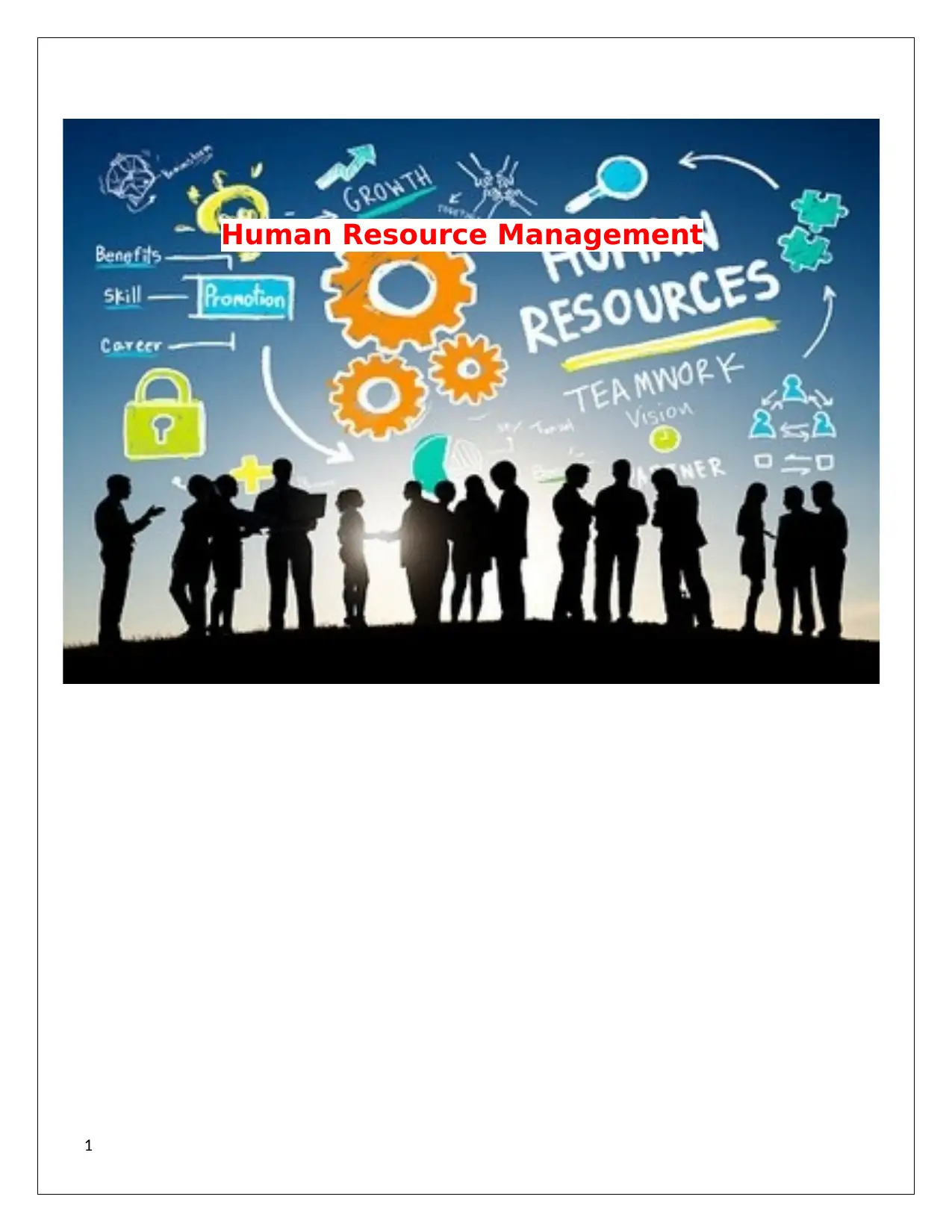
Human Resource Management
1
1
Paraphrase This Document
Need a fresh take? Get an instant paraphrase of this document with our AI Paraphraser
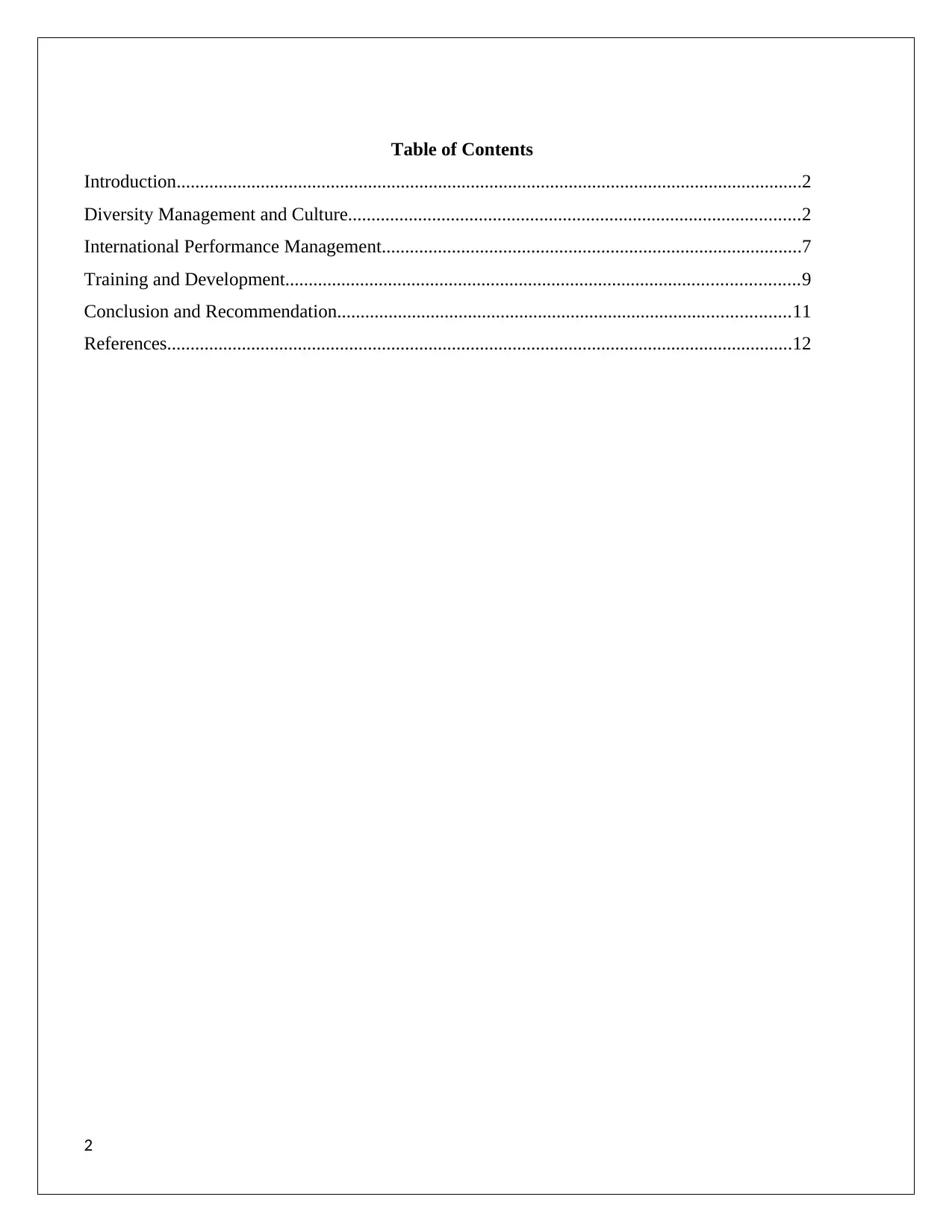
Table of Contents
Introduction......................................................................................................................................2
Diversity Management and Culture.................................................................................................2
International Performance Management..........................................................................................7
Training and Development..............................................................................................................9
Conclusion and Recommendation.................................................................................................11
References......................................................................................................................................12
2
Introduction......................................................................................................................................2
Diversity Management and Culture.................................................................................................2
International Performance Management..........................................................................................7
Training and Development..............................................................................................................9
Conclusion and Recommendation.................................................................................................11
References......................................................................................................................................12
2
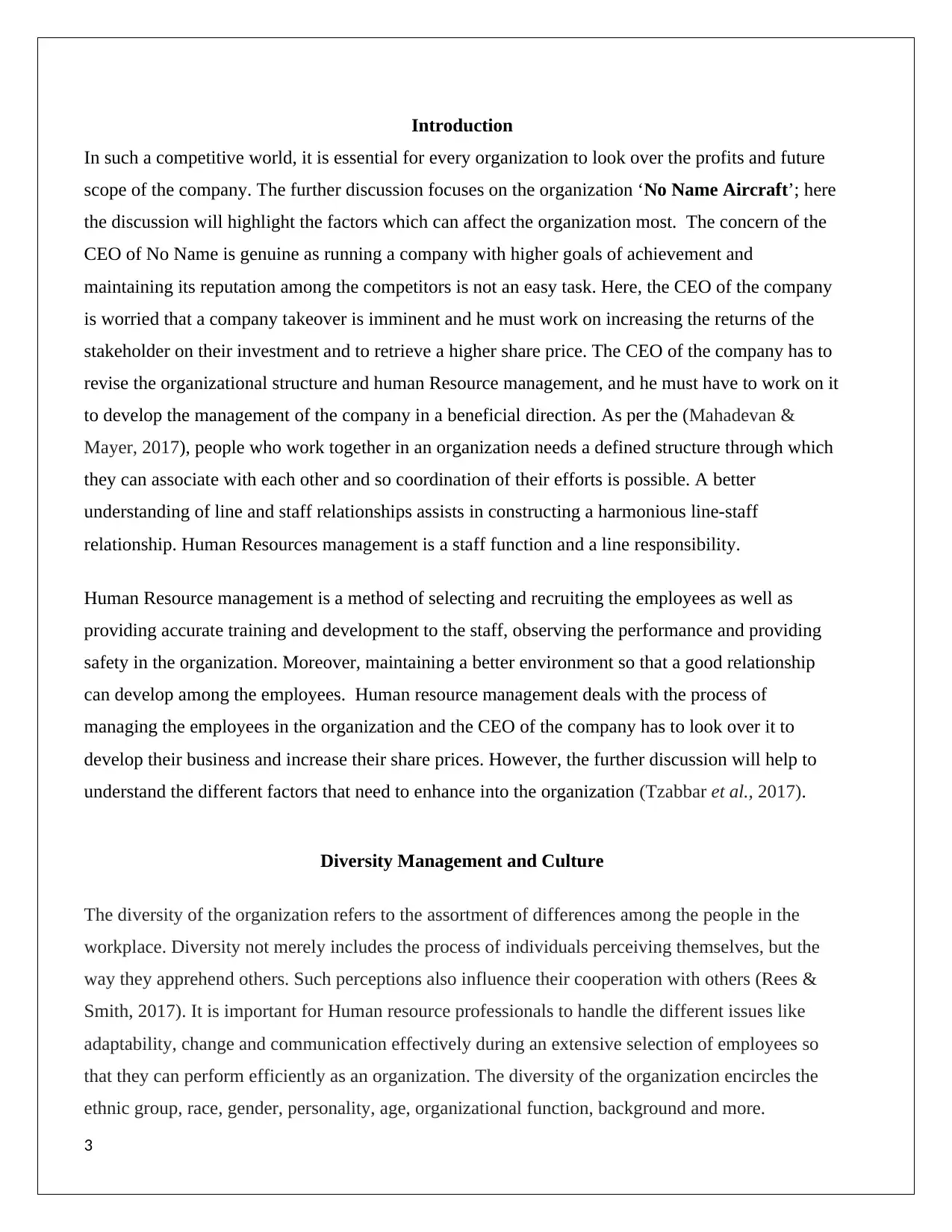
Introduction
In such a competitive world, it is essential for every organization to look over the profits and future
scope of the company. The further discussion focuses on the organization ‘No Name Aircraft’; here
the discussion will highlight the factors which can affect the organization most. The concern of the
CEO of No Name is genuine as running a company with higher goals of achievement and
maintaining its reputation among the competitors is not an easy task. Here, the CEO of the company
is worried that a company takeover is imminent and he must work on increasing the returns of the
stakeholder on their investment and to retrieve a higher share price. The CEO of the company has to
revise the organizational structure and human Resource management, and he must have to work on it
to develop the management of the company in a beneficial direction. As per the (Mahadevan &
Mayer, 2017), people who work together in an organization needs a defined structure through which
they can associate with each other and so coordination of their efforts is possible. A better
understanding of line and staff relationships assists in constructing a harmonious line-staff
relationship. Human Resources management is a staff function and a line responsibility.
Human Resource management is a method of selecting and recruiting the employees as well as
providing accurate training and development to the staff, observing the performance and providing
safety in the organization. Moreover, maintaining a better environment so that a good relationship
can develop among the employees. Human resource management deals with the process of
managing the employees in the organization and the CEO of the company has to look over it to
develop their business and increase their share prices. However, the further discussion will help to
understand the different factors that need to enhance into the organization (Tzabbar et al., 2017).
Diversity Management and Culture
The diversity of the organization refers to the assortment of differences among the people in the
workplace. Diversity not merely includes the process of individuals perceiving themselves, but the
way they apprehend others. Such perceptions also influence their cooperation with others (Rees &
Smith, 2017). It is important for Human resource professionals to handle the different issues like
adaptability, change and communication effectively during an extensive selection of employees so
that they can perform efficiently as an organization. The diversity of the organization encircles the
ethnic group, race, gender, personality, age, organizational function, background and more.
3
In such a competitive world, it is essential for every organization to look over the profits and future
scope of the company. The further discussion focuses on the organization ‘No Name Aircraft’; here
the discussion will highlight the factors which can affect the organization most. The concern of the
CEO of No Name is genuine as running a company with higher goals of achievement and
maintaining its reputation among the competitors is not an easy task. Here, the CEO of the company
is worried that a company takeover is imminent and he must work on increasing the returns of the
stakeholder on their investment and to retrieve a higher share price. The CEO of the company has to
revise the organizational structure and human Resource management, and he must have to work on it
to develop the management of the company in a beneficial direction. As per the (Mahadevan &
Mayer, 2017), people who work together in an organization needs a defined structure through which
they can associate with each other and so coordination of their efforts is possible. A better
understanding of line and staff relationships assists in constructing a harmonious line-staff
relationship. Human Resources management is a staff function and a line responsibility.
Human Resource management is a method of selecting and recruiting the employees as well as
providing accurate training and development to the staff, observing the performance and providing
safety in the organization. Moreover, maintaining a better environment so that a good relationship
can develop among the employees. Human resource management deals with the process of
managing the employees in the organization and the CEO of the company has to look over it to
develop their business and increase their share prices. However, the further discussion will help to
understand the different factors that need to enhance into the organization (Tzabbar et al., 2017).
Diversity Management and Culture
The diversity of the organization refers to the assortment of differences among the people in the
workplace. Diversity not merely includes the process of individuals perceiving themselves, but the
way they apprehend others. Such perceptions also influence their cooperation with others (Rees &
Smith, 2017). It is important for Human resource professionals to handle the different issues like
adaptability, change and communication effectively during an extensive selection of employees so
that they can perform efficiently as an organization. The diversity of the organization encircles the
ethnic group, race, gender, personality, age, organizational function, background and more.
3
⊘ This is a preview!⊘
Do you want full access?
Subscribe today to unlock all pages.

Trusted by 1+ million students worldwide
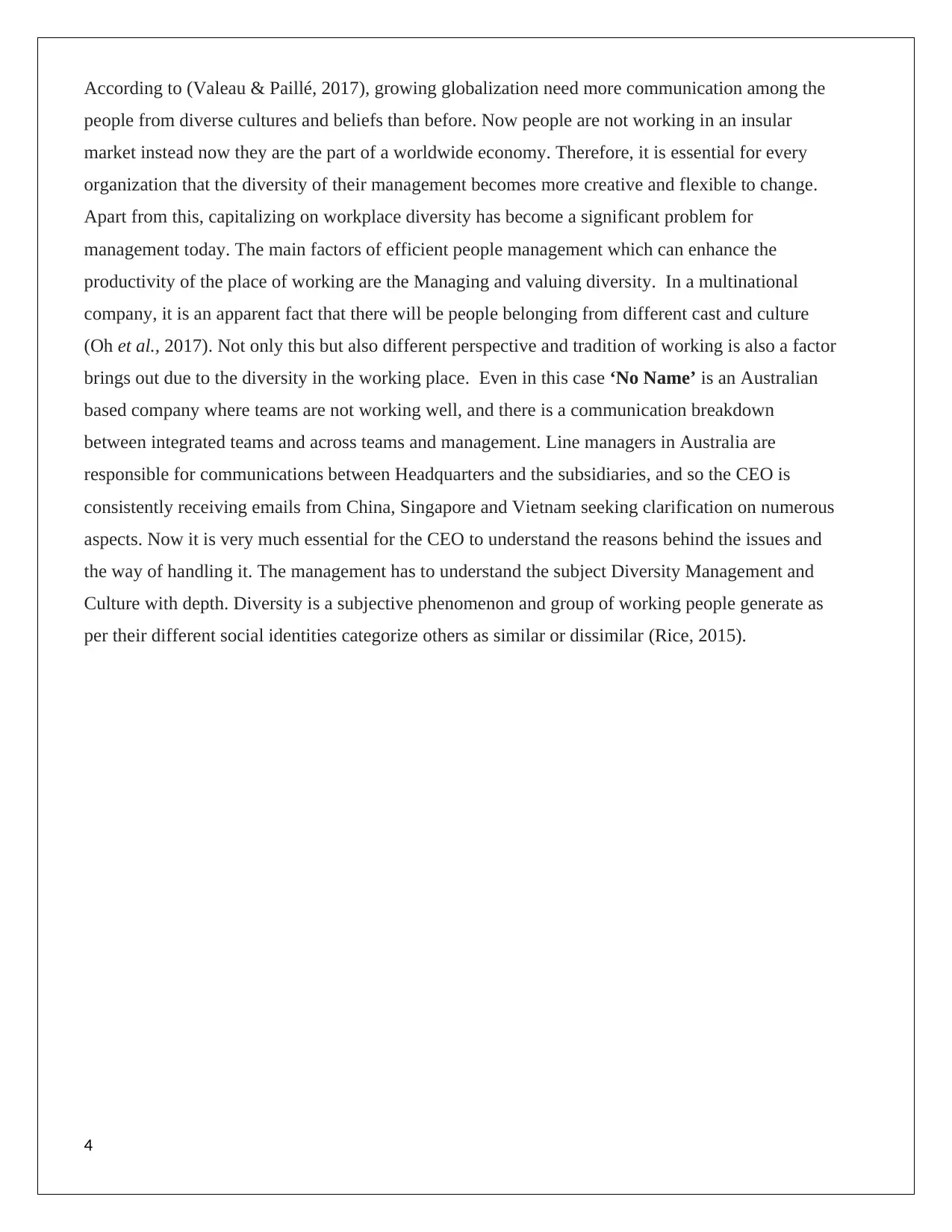
According to (Valeau & Paillé, 2017), growing globalization need more communication among the
people from diverse cultures and beliefs than before. Now people are not working in an insular
market instead now they are the part of a worldwide economy. Therefore, it is essential for every
organization that the diversity of their management becomes more creative and flexible to change.
Apart from this, capitalizing on workplace diversity has become a significant problem for
management today. The main factors of efficient people management which can enhance the
productivity of the place of working are the Managing and valuing diversity. In a multinational
company, it is an apparent fact that there will be people belonging from different cast and culture
(Oh et al., 2017). Not only this but also different perspective and tradition of working is also a factor
brings out due to the diversity in the working place. Even in this case ‘No Name’ is an Australian
based company where teams are not working well, and there is a communication breakdown
between integrated teams and across teams and management. Line managers in Australia are
responsible for communications between Headquarters and the subsidiaries, and so the CEO is
consistently receiving emails from China, Singapore and Vietnam seeking clarification on numerous
aspects. Now it is very much essential for the CEO to understand the reasons behind the issues and
the way of handling it. The management has to understand the subject Diversity Management and
Culture with depth. Diversity is a subjective phenomenon and group of working people generate as
per their different social identities categorize others as similar or dissimilar (Rice, 2015).
4
people from diverse cultures and beliefs than before. Now people are not working in an insular
market instead now they are the part of a worldwide economy. Therefore, it is essential for every
organization that the diversity of their management becomes more creative and flexible to change.
Apart from this, capitalizing on workplace diversity has become a significant problem for
management today. The main factors of efficient people management which can enhance the
productivity of the place of working are the Managing and valuing diversity. In a multinational
company, it is an apparent fact that there will be people belonging from different cast and culture
(Oh et al., 2017). Not only this but also different perspective and tradition of working is also a factor
brings out due to the diversity in the working place. Even in this case ‘No Name’ is an Australian
based company where teams are not working well, and there is a communication breakdown
between integrated teams and across teams and management. Line managers in Australia are
responsible for communications between Headquarters and the subsidiaries, and so the CEO is
consistently receiving emails from China, Singapore and Vietnam seeking clarification on numerous
aspects. Now it is very much essential for the CEO to understand the reasons behind the issues and
the way of handling it. The management has to understand the subject Diversity Management and
Culture with depth. Diversity is a subjective phenomenon and group of working people generate as
per their different social identities categorize others as similar or dissimilar (Rice, 2015).
4
Paraphrase This Document
Need a fresh take? Get an instant paraphrase of this document with our AI Paraphraser

Figure: 1
Primary dimensions
o Disability
o Ethnicity
o Gender
o Race
o Age
Secondary dimensions
o Nationality
o Geographic origin
o Education
o Thinking style
o Family status
o Sexual orientation
o Lifestyle
5
DimensionsofDiversityTertiaryDimensionsSecondaryDimensionsPrimaryDimensions
Primary dimensions
o Disability
o Ethnicity
o Gender
o Race
o Age
Secondary dimensions
o Nationality
o Geographic origin
o Education
o Thinking style
o Family status
o Sexual orientation
o Lifestyle
5
DimensionsofDiversityTertiaryDimensionsSecondaryDimensionsPrimaryDimensions
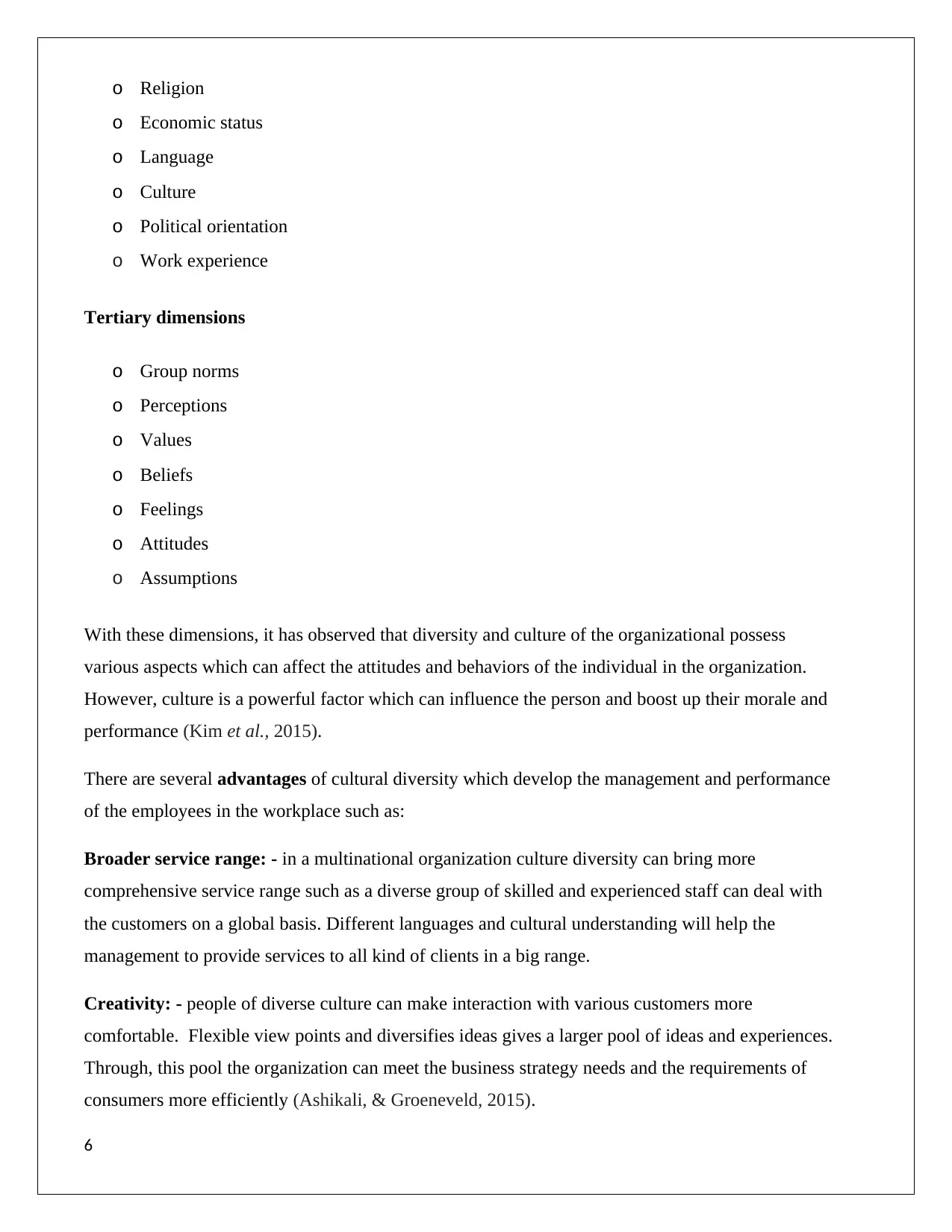
o Religion
o Economic status
o Language
o Culture
o Political orientation
o Work experience
Tertiary dimensions
o Group norms
o Perceptions
o Values
o Beliefs
o Feelings
o Attitudes
o Assumptions
With these dimensions, it has observed that diversity and culture of the organizational possess
various aspects which can affect the attitudes and behaviors of the individual in the organization.
However, culture is a powerful factor which can influence the person and boost up their morale and
performance (Kim et al., 2015).
There are several advantages of cultural diversity which develop the management and performance
of the employees in the workplace such as:
Broader service range: - in a multinational organization culture diversity can bring more
comprehensive service range such as a diverse group of skilled and experienced staff can deal with
the customers on a global basis. Different languages and cultural understanding will help the
management to provide services to all kind of clients in a big range.
Creativity: - people of diverse culture can make interaction with various customers more
comfortable. Flexible view points and diversifies ideas gives a larger pool of ideas and experiences.
Through, this pool the organization can meet the business strategy needs and the requirements of
consumers more efficiently (Ashikali, & Groeneveld, 2015).
6
o Economic status
o Language
o Culture
o Political orientation
o Work experience
Tertiary dimensions
o Group norms
o Perceptions
o Values
o Beliefs
o Feelings
o Attitudes
o Assumptions
With these dimensions, it has observed that diversity and culture of the organizational possess
various aspects which can affect the attitudes and behaviors of the individual in the organization.
However, culture is a powerful factor which can influence the person and boost up their morale and
performance (Kim et al., 2015).
There are several advantages of cultural diversity which develop the management and performance
of the employees in the workplace such as:
Broader service range: - in a multinational organization culture diversity can bring more
comprehensive service range such as a diverse group of skilled and experienced staff can deal with
the customers on a global basis. Different languages and cultural understanding will help the
management to provide services to all kind of clients in a big range.
Creativity: - people of diverse culture can make interaction with various customers more
comfortable. Flexible view points and diversifies ideas gives a larger pool of ideas and experiences.
Through, this pool the organization can meet the business strategy needs and the requirements of
consumers more efficiently (Ashikali, & Groeneveld, 2015).
6
⊘ This is a preview!⊘
Do you want full access?
Subscribe today to unlock all pages.

Trusted by 1+ million students worldwide

Increased adaptability: - Staff from diverse backgrounds can carry out the talents of individual and
experiences in implying the ideas that are formable in adapting to fluctuating markets and customer
needs and this will help to provide the variety of solution to all the day to day issues.
Apart from all the advantages of Diversity Management and Culture, there are also some challenges
to it faced by the management of organizations. Those are:
Unconscious bias: - It is one of the important factors which bring barriers for organizations in the
process of embracing the diverse management and culture. Therefore, as it is an unconscious bias, so
it makes everything more challenging to overcome (Lauring, 2013).
Communication: - In culture, diversity communication is another challenge in an organization
which is an outcome of fundamental differences in the way of communication and different
meanings related to non-verbal signals. It can generate issues among the employees due to the lack
of understanding among each other because of the different languages and style of communicating.
At ‘No Name’, staffs should have to understand each other, to have effective communication and to
value the diversity that exists throughout the organization.
However, with the research, it is also noticed that the above-mentioned each challenge can be
overcome if there are more awareness and skill by organizing different training program at all level.
By this discussion, the CEO of the No Name can learn the method of handling the issues of cultural
diversity factor and the process of implementing this into their organization of every county (Reiche
et al., 2016).
Communications Education and Training Employee Involvement
CEO speeches Diversity instruction Task forces on diversity
Written diversity policy;
ddiversity brochures
Awareness training Interest groups for members of
diverse populations
Reports to the public or to
shareholders
Diversity skill training &
Multicultural team training
Company time provided for
diversity planning & Networking
groups
Table: 1
7
experiences in implying the ideas that are formable in adapting to fluctuating markets and customer
needs and this will help to provide the variety of solution to all the day to day issues.
Apart from all the advantages of Diversity Management and Culture, there are also some challenges
to it faced by the management of organizations. Those are:
Unconscious bias: - It is one of the important factors which bring barriers for organizations in the
process of embracing the diverse management and culture. Therefore, as it is an unconscious bias, so
it makes everything more challenging to overcome (Lauring, 2013).
Communication: - In culture, diversity communication is another challenge in an organization
which is an outcome of fundamental differences in the way of communication and different
meanings related to non-verbal signals. It can generate issues among the employees due to the lack
of understanding among each other because of the different languages and style of communicating.
At ‘No Name’, staffs should have to understand each other, to have effective communication and to
value the diversity that exists throughout the organization.
However, with the research, it is also noticed that the above-mentioned each challenge can be
overcome if there are more awareness and skill by organizing different training program at all level.
By this discussion, the CEO of the No Name can learn the method of handling the issues of cultural
diversity factor and the process of implementing this into their organization of every county (Reiche
et al., 2016).
Communications Education and Training Employee Involvement
CEO speeches Diversity instruction Task forces on diversity
Written diversity policy;
ddiversity brochures
Awareness training Interest groups for members of
diverse populations
Reports to the public or to
shareholders
Diversity skill training &
Multicultural team training
Company time provided for
diversity planning & Networking
groups
Table: 1
7
Paraphrase This Document
Need a fresh take? Get an instant paraphrase of this document with our AI Paraphraser
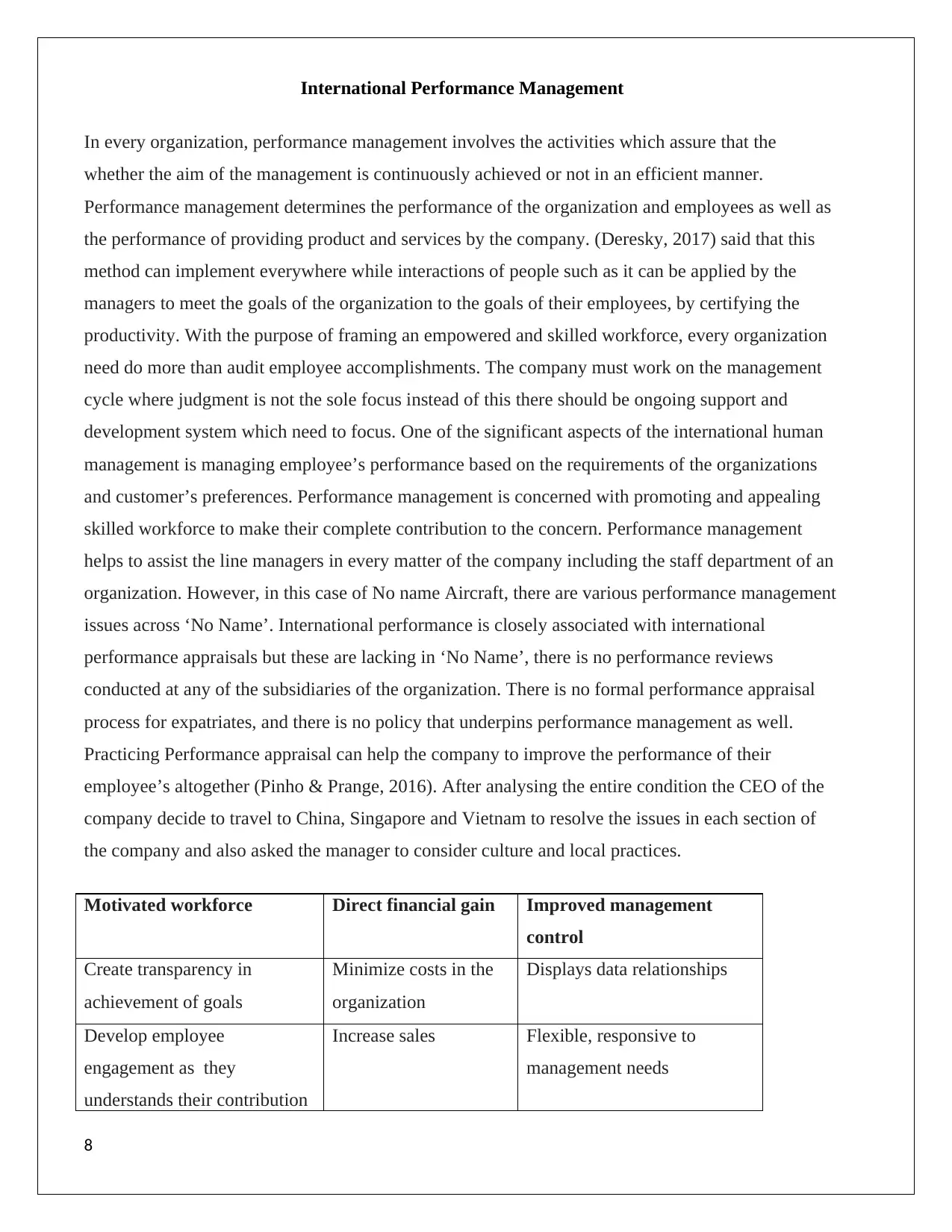
International Performance Management
In every organization, performance management involves the activities which assure that the
whether the aim of the management is continuously achieved or not in an efficient manner.
Performance management determines the performance of the organization and employees as well as
the performance of providing product and services by the company. (Deresky, 2017) said that this
method can implement everywhere while interactions of people such as it can be applied by the
managers to meet the goals of the organization to the goals of their employees, by certifying the
productivity. With the purpose of framing an empowered and skilled workforce, every organization
need do more than audit employee accomplishments. The company must work on the management
cycle where judgment is not the sole focus instead of this there should be ongoing support and
development system which need to focus. One of the significant aspects of the international human
management is managing employee’s performance based on the requirements of the organizations
and customer’s preferences. Performance management is concerned with promoting and appealing
skilled workforce to make their complete contribution to the concern. Performance management
helps to assist the line managers in every matter of the company including the staff department of an
organization. However, in this case of No name Aircraft, there are various performance management
issues across ‘No Name’. International performance is closely associated with international
performance appraisals but these are lacking in ‘No Name’, there is no performance reviews
conducted at any of the subsidiaries of the organization. There is no formal performance appraisal
process for expatriates, and there is no policy that underpins performance management as well.
Practicing Performance appraisal can help the company to improve the performance of their
employee’s altogether (Pinho & Prange, 2016). After analysing the entire condition the CEO of the
company decide to travel to China, Singapore and Vietnam to resolve the issues in each section of
the company and also asked the manager to consider culture and local practices.
Motivated workforce Direct financial gain Improved management
control
Create transparency in
achievement of goals
Minimize costs in the
organization
Displays data relationships
Develop employee
engagement as they
understands their contribution
Increase sales Flexible, responsive to
management needs
8
In every organization, performance management involves the activities which assure that the
whether the aim of the management is continuously achieved or not in an efficient manner.
Performance management determines the performance of the organization and employees as well as
the performance of providing product and services by the company. (Deresky, 2017) said that this
method can implement everywhere while interactions of people such as it can be applied by the
managers to meet the goals of the organization to the goals of their employees, by certifying the
productivity. With the purpose of framing an empowered and skilled workforce, every organization
need do more than audit employee accomplishments. The company must work on the management
cycle where judgment is not the sole focus instead of this there should be ongoing support and
development system which need to focus. One of the significant aspects of the international human
management is managing employee’s performance based on the requirements of the organizations
and customer’s preferences. Performance management is concerned with promoting and appealing
skilled workforce to make their complete contribution to the concern. Performance management
helps to assist the line managers in every matter of the company including the staff department of an
organization. However, in this case of No name Aircraft, there are various performance management
issues across ‘No Name’. International performance is closely associated with international
performance appraisals but these are lacking in ‘No Name’, there is no performance reviews
conducted at any of the subsidiaries of the organization. There is no formal performance appraisal
process for expatriates, and there is no policy that underpins performance management as well.
Practicing Performance appraisal can help the company to improve the performance of their
employee’s altogether (Pinho & Prange, 2016). After analysing the entire condition the CEO of the
company decide to travel to China, Singapore and Vietnam to resolve the issues in each section of
the company and also asked the manager to consider culture and local practices.
Motivated workforce Direct financial gain Improved management
control
Create transparency in
achievement of goals
Minimize costs in the
organization
Displays data relationships
Develop employee
engagement as they
understands their contribution
Increase sales Flexible, responsive to
management needs
8
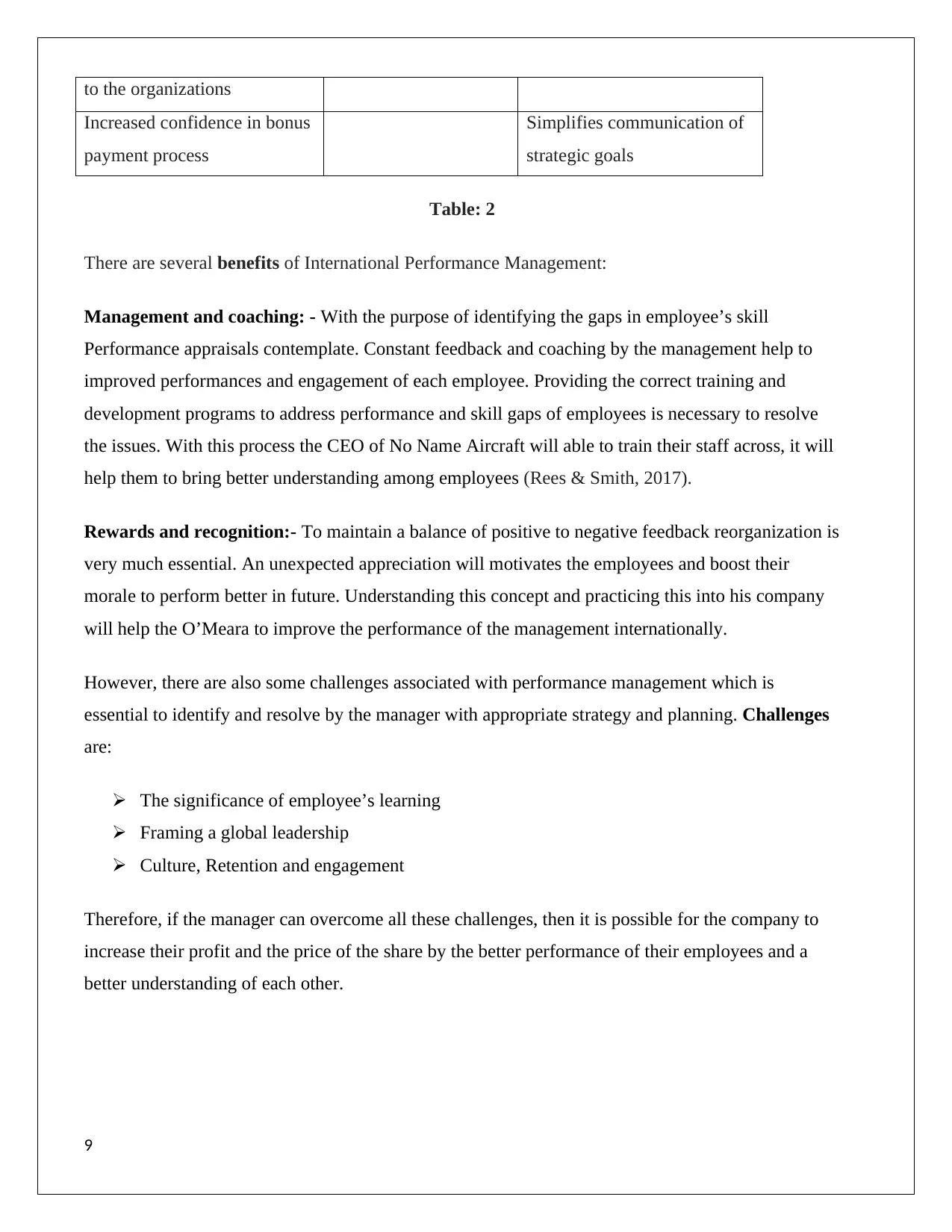
to the organizations
Increased confidence in bonus
payment process
Simplifies communication of
strategic goals
Table: 2
There are several benefits of International Performance Management:
Management and coaching: - With the purpose of identifying the gaps in employee’s skill
Performance appraisals contemplate. Constant feedback and coaching by the management help to
improved performances and engagement of each employee. Providing the correct training and
development programs to address performance and skill gaps of employees is necessary to resolve
the issues. With this process the CEO of No Name Aircraft will able to train their staff across, it will
help them to bring better understanding among employees (Rees & Smith, 2017).
Rewards and recognition:- To maintain a balance of positive to negative feedback reorganization is
very much essential. An unexpected appreciation will motivates the employees and boost their
morale to perform better in future. Understanding this concept and practicing this into his company
will help the O’Meara to improve the performance of the management internationally.
However, there are also some challenges associated with performance management which is
essential to identify and resolve by the manager with appropriate strategy and planning. Challenges
are:
The significance of employee’s learning
Framing a global leadership
Culture, Retention and engagement
Therefore, if the manager can overcome all these challenges, then it is possible for the company to
increase their profit and the price of the share by the better performance of their employees and a
better understanding of each other.
9
Increased confidence in bonus
payment process
Simplifies communication of
strategic goals
Table: 2
There are several benefits of International Performance Management:
Management and coaching: - With the purpose of identifying the gaps in employee’s skill
Performance appraisals contemplate. Constant feedback and coaching by the management help to
improved performances and engagement of each employee. Providing the correct training and
development programs to address performance and skill gaps of employees is necessary to resolve
the issues. With this process the CEO of No Name Aircraft will able to train their staff across, it will
help them to bring better understanding among employees (Rees & Smith, 2017).
Rewards and recognition:- To maintain a balance of positive to negative feedback reorganization is
very much essential. An unexpected appreciation will motivates the employees and boost their
morale to perform better in future. Understanding this concept and practicing this into his company
will help the O’Meara to improve the performance of the management internationally.
However, there are also some challenges associated with performance management which is
essential to identify and resolve by the manager with appropriate strategy and planning. Challenges
are:
The significance of employee’s learning
Framing a global leadership
Culture, Retention and engagement
Therefore, if the manager can overcome all these challenges, then it is possible for the company to
increase their profit and the price of the share by the better performance of their employees and a
better understanding of each other.
9
⊘ This is a preview!⊘
Do you want full access?
Subscribe today to unlock all pages.

Trusted by 1+ million students worldwide
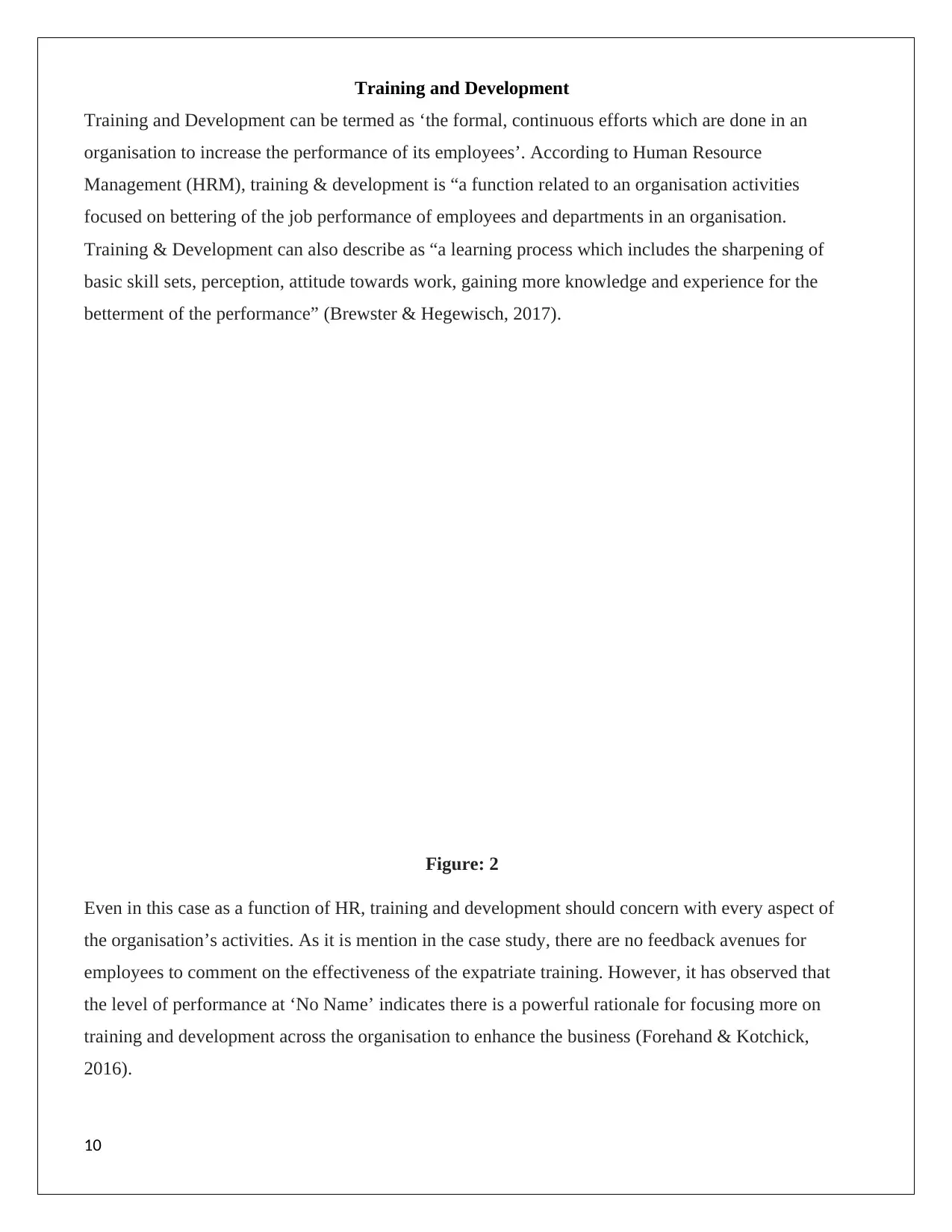
Training and Development
Training and Development can be termed as ‘the formal, continuous efforts which are done in an
organisation to increase the performance of its employees’. According to Human Resource
Management (HRM), training & development is “a function related to an organisation activities
focused on bettering of the job performance of employees and departments in an organisation.
Training & Development can also describe as “a learning process which includes the sharpening of
basic skill sets, perception, attitude towards work, gaining more knowledge and experience for the
betterment of the performance” (Brewster & Hegewisch, 2017).
Figure: 2
Even in this case as a function of HR, training and development should concern with every aspect of
the organisation’s activities. As it is mention in the case study, there are no feedback avenues for
employees to comment on the effectiveness of the expatriate training. However, it has observed that
the level of performance at ‘No Name’ indicates there is a powerful rationale for focusing more on
training and development across the organisation to enhance the business (Forehand & Kotchick,
2016).
10
DevelopmentEducationTraining
Training and Development can be termed as ‘the formal, continuous efforts which are done in an
organisation to increase the performance of its employees’. According to Human Resource
Management (HRM), training & development is “a function related to an organisation activities
focused on bettering of the job performance of employees and departments in an organisation.
Training & Development can also describe as “a learning process which includes the sharpening of
basic skill sets, perception, attitude towards work, gaining more knowledge and experience for the
betterment of the performance” (Brewster & Hegewisch, 2017).
Figure: 2
Even in this case as a function of HR, training and development should concern with every aspect of
the organisation’s activities. As it is mention in the case study, there are no feedback avenues for
employees to comment on the effectiveness of the expatriate training. However, it has observed that
the level of performance at ‘No Name’ indicates there is a powerful rationale for focusing more on
training and development across the organisation to enhance the business (Forehand & Kotchick,
2016).
10
DevelopmentEducationTraining
Paraphrase This Document
Need a fresh take? Get an instant paraphrase of this document with our AI Paraphraser

There are various benefits while implementing the training and development process appropriately,
such as:
Increase in Production: It will improve the efficiency and productivity of employees of No name
Aircraft. Well trained candidates can help the organisation to grow in every respect both in quality
and quantity. There is also less wastage of money, resource and time when candidates trained
properly (Subramaniam et al., 2016).
Reduction of mistakes: Errors mostly take place due to lack of desired knowledge and skill
required by the employee. Training and Development help to reduce the accidents and errors. The
more trained an employee is, there are fewer chances of committing mistakes in that job.
Espirit de corps (Team Spirit): It also helps in building a sense of team spirit, inter-team
collaborations. It contributes to inculcate the zeal within the employees.
Skill Development: Training and Development increase the knowledge and skill of employees at
each point of point. It helps to build the new horizons of our intellect and overall personality of all
employees.
Optimum Resource Utilisation: Training and Development help to give an opportunity and makes
an architect for the development of human resource, behaviour skills, personality skills, technical
expertise for the optimum utilisation of resources.
Increased Consistency: A well-trained employee can have constant knowledge and experience
which can be very helpful for the organisation. Well- trained employees will make less error and
therefore will help to increase consistency (Mengistu, 2016). It also ensures that the tasks are
completed on time and with no issues, and there should be no question about how the work should
do.
Types of Employee Training over which the company should need to give focus while conducting
their training and development program are:
Communication: Today’s world requires a broad range of languages and customs which improve
the workforce.
Computer Skills: For administrative and office tasks it is necessary to have basic computer skills.
11
such as:
Increase in Production: It will improve the efficiency and productivity of employees of No name
Aircraft. Well trained candidates can help the organisation to grow in every respect both in quality
and quantity. There is also less wastage of money, resource and time when candidates trained
properly (Subramaniam et al., 2016).
Reduction of mistakes: Errors mostly take place due to lack of desired knowledge and skill
required by the employee. Training and Development help to reduce the accidents and errors. The
more trained an employee is, there are fewer chances of committing mistakes in that job.
Espirit de corps (Team Spirit): It also helps in building a sense of team spirit, inter-team
collaborations. It contributes to inculcate the zeal within the employees.
Skill Development: Training and Development increase the knowledge and skill of employees at
each point of point. It helps to build the new horizons of our intellect and overall personality of all
employees.
Optimum Resource Utilisation: Training and Development help to give an opportunity and makes
an architect for the development of human resource, behaviour skills, personality skills, technical
expertise for the optimum utilisation of resources.
Increased Consistency: A well-trained employee can have constant knowledge and experience
which can be very helpful for the organisation. Well- trained employees will make less error and
therefore will help to increase consistency (Mengistu, 2016). It also ensures that the tasks are
completed on time and with no issues, and there should be no question about how the work should
do.
Types of Employee Training over which the company should need to give focus while conducting
their training and development program are:
Communication: Today’s world requires a broad range of languages and customs which improve
the workforce.
Computer Skills: For administrative and office tasks it is necessary to have basic computer skills.
11
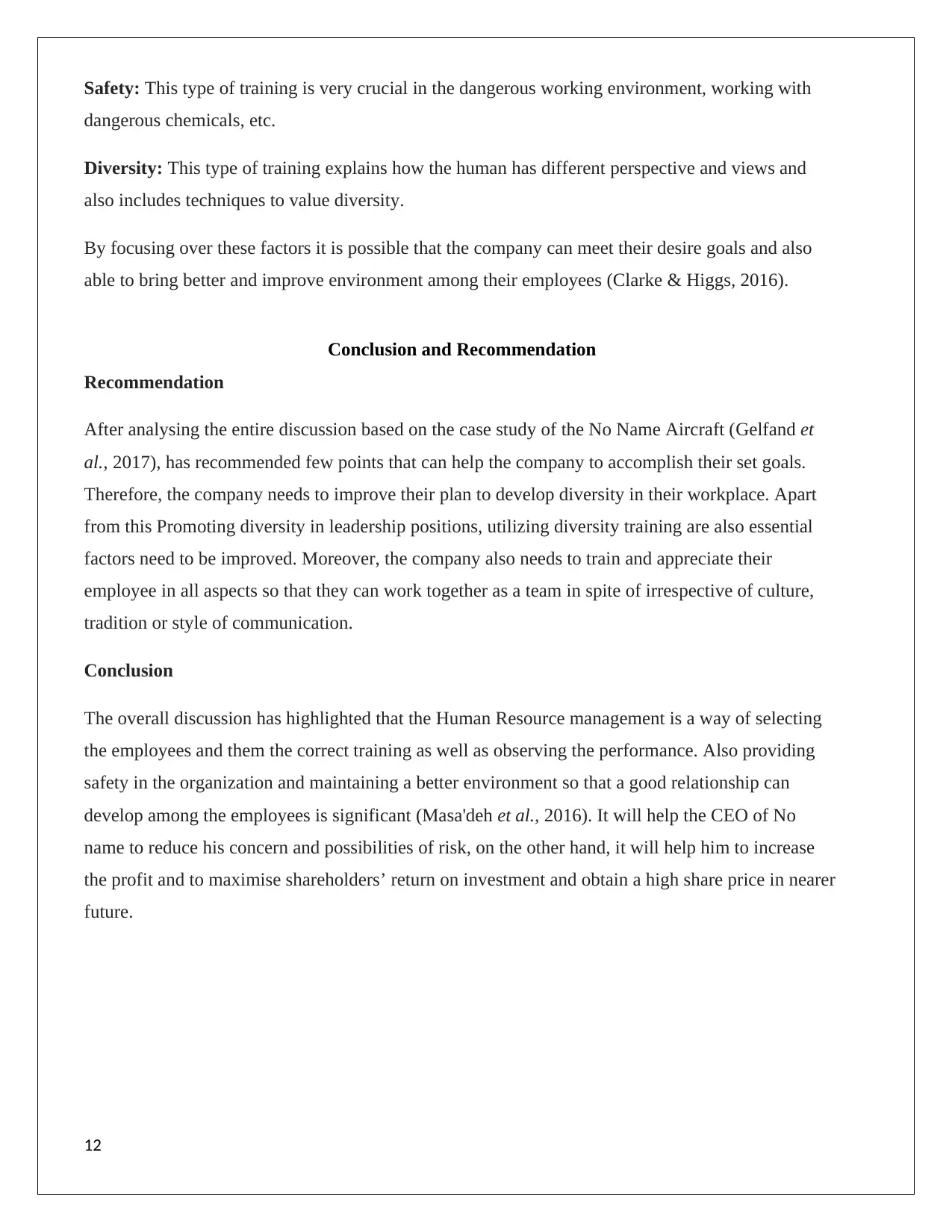
Safety: This type of training is very crucial in the dangerous working environment, working with
dangerous chemicals, etc.
Diversity: This type of training explains how the human has different perspective and views and
also includes techniques to value diversity.
By focusing over these factors it is possible that the company can meet their desire goals and also
able to bring better and improve environment among their employees (Clarke & Higgs, 2016).
Conclusion and Recommendation
Recommendation
After analysing the entire discussion based on the case study of the No Name Aircraft (Gelfand et
al., 2017), has recommended few points that can help the company to accomplish their set goals.
Therefore, the company needs to improve their plan to develop diversity in their workplace. Apart
from this Promoting diversity in leadership positions, utilizing diversity training are also essential
factors need to be improved. Moreover, the company also needs to train and appreciate their
employee in all aspects so that they can work together as a team in spite of irrespective of culture,
tradition or style of communication.
Conclusion
The overall discussion has highlighted that the Human Resource management is a way of selecting
the employees and them the correct training as well as observing the performance. Also providing
safety in the organization and maintaining a better environment so that a good relationship can
develop among the employees is significant (Masa'deh et al., 2016). It will help the CEO of No
name to reduce his concern and possibilities of risk, on the other hand, it will help him to increase
the profit and to maximise shareholders’ return on investment and obtain a high share price in nearer
future.
12
dangerous chemicals, etc.
Diversity: This type of training explains how the human has different perspective and views and
also includes techniques to value diversity.
By focusing over these factors it is possible that the company can meet their desire goals and also
able to bring better and improve environment among their employees (Clarke & Higgs, 2016).
Conclusion and Recommendation
Recommendation
After analysing the entire discussion based on the case study of the No Name Aircraft (Gelfand et
al., 2017), has recommended few points that can help the company to accomplish their set goals.
Therefore, the company needs to improve their plan to develop diversity in their workplace. Apart
from this Promoting diversity in leadership positions, utilizing diversity training are also essential
factors need to be improved. Moreover, the company also needs to train and appreciate their
employee in all aspects so that they can work together as a team in spite of irrespective of culture,
tradition or style of communication.
Conclusion
The overall discussion has highlighted that the Human Resource management is a way of selecting
the employees and them the correct training as well as observing the performance. Also providing
safety in the organization and maintaining a better environment so that a good relationship can
develop among the employees is significant (Masa'deh et al., 2016). It will help the CEO of No
name to reduce his concern and possibilities of risk, on the other hand, it will help him to increase
the profit and to maximise shareholders’ return on investment and obtain a high share price in nearer
future.
12
⊘ This is a preview!⊘
Do you want full access?
Subscribe today to unlock all pages.

Trusted by 1+ million students worldwide
1 out of 14
Related Documents
Your All-in-One AI-Powered Toolkit for Academic Success.
+13062052269
info@desklib.com
Available 24*7 on WhatsApp / Email
![[object Object]](/_next/static/media/star-bottom.7253800d.svg)
Unlock your academic potential
Copyright © 2020–2025 A2Z Services. All Rights Reserved. Developed and managed by ZUCOL.





